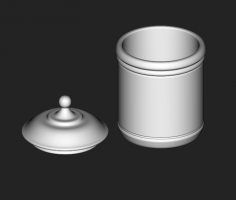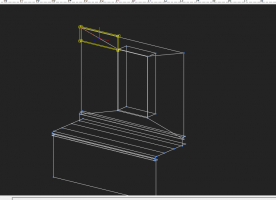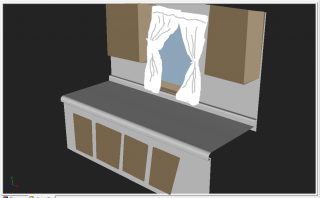
MikeV
Craftsman/Mentor-
Posts
164 -
Joined
-
Last visited
Previous Fields
-
Interests
In no particular order...<br />Music, movies, books, anything creative, dark humor, sarcastic humor, meeting and talking with cool people, gaming, game design, animation, storytelling...
-
Hardware Platform
Windows
-
System Description
Home-built system with AMD Phenom x4 (unlocked to x6), 8 Gigs RAM, Nvidia 560ti video card running Windows 7 64-bit off a SSD drive (awesome little thing).
-
Mid Term Goals
Become proficient with A:M, get these story ideas stuck in my head out onto the computer screen and have fun in the process
-
Self Assessment: Animation Skill
Unfamiliar
-
Self Assessment: Modeling Skill
Unfamiliar
-
Self Assessment: Rigging Skill
Unfamiliar
Profile Information
-
Name
Mike
-
Location
Beautiful Catskill Mountains, NY
Recent Profile Visitors
1,251 profile views
MikeV's Achievements

Journeyman (4/10)
0
Reputation
-
Yeah. The most important thing, I figure, is to keep moving forward and keep working on stuff. My current challenge is finding a good set of comprehensive tutorials on materials. I can't seem to find any. Most I find are for very specific applications. I'm sure I'll find something though.
-
Seriously? Someone else nutty enough to live in Small-Bany??? I'm in Scotia...lovely little Scotia. Actually, I'm in Mt. Marion, about 5 minutes from Woodstock, about 10 from Kingston. I figured Albany might be more recognizable as an overall region. Google maps says I'm about an hour S. of you. Google Maps has been wrong before, though. straight up the thruway...sounds about right.. Nice! Well, howdy neighbor!
-
I just realized I had set my birth year wrong in my settings. The forums said I'm 38. I'm actually 39 today :-p I also learned I share the same birthday with Kevin Smith! So that's kinda cool
-
In the meantime... Got my first "prop" model done... Just need to work on the material for it now. I'm gonna look for some good material tutorials and see what I can learn. Cap and main canister are separate objects, so I can have them not on fully or what not, just to add a bit of "life" to the setting. Also, the cap actually properly fits the opening... so that's a bonus :-p. Lathing an object isn't a major challenge, and so this is more just a "I got this part done on this day" sort of mile-marker. Will be interesting to go back and look at how things progressed later on. Here's a quick render of it...
-
Thanks everyone! @Rodney Splines.... -whimper- lol
-
Okay... quick self-check here. I'm filling out and tweaking the basic counter/cabinet set right now, just getting things into a scale I can work with, etc. I put a window into my back wall using the approach Jeff Cantin describes on his site (or at least how I understood it). However, I am finding that there are 4 dead-end splines connecting the main wall spline to the window spline. I could probably re-connect them so they flow into the splines forming the frame of the window, but then I'd have to contend with the splines wanting to curve. Which I don't want, obviously. What I'm wondering is, since it's a flat surface and the intention is to have a somewhat sharp corner where the wall meets the window, is it an exception to the "no dead-ends", or at least permissible in this case? Is there a different/better way I should be doing it? I want to get this right and I want to learn the right way to do this stuff as early as possible, and if doing things over is what it takes to drill it into my head, then that's what I'll do... Here's a shot of it... Thanks!
-
You know, it's funny you mention that, because on the way home from work, I was thinking about setting up the "proxy models" that Rodney mentioned earlier in the thread, for things like the cabinets and such. Given the "project" nature of A:M, I can easily create the basic/starting models - making sure to bevel the edges as you note (which would definitely be good practice) - and just have those models ready for when it's time to complete the finished objects. And then I got to thinking, well, some things are fairly straight-forward to model.. like a bowl, or a canister (for sugar, flour, etc). Things like that. And I want to do the whole thing with having "Sugar" and such "embossed" into the surface of the canisters, which I think would be a good candidate for becoming more familiar with the material system which I haven't delved into too much yet. I'd like to get a sorta polished earthenware look which, I imagine, would require the use of a few of the settings and such. So that should be good practice. So... it's not taking as long as I thought it might, but I'm feeling that "bug" coming back to create stuff. Which is good! Certainly not complaining about that!
-
Hey, thanks all! Gotta say, this is the first time I've had a thread started specifically to wish me one on a forum. Cool!
-
Hey Rodney, I was just thinking (stand back! it could get messy!) Since this thread has basically morphed from a "one-off" post and is likely going to become about a work in progress, perhaps it would be better to move it to that forum section? Was just thinking about that.
-
Thanks for that! Yeah, I like to always keep the creativity flowing, and I hate letting things "beat me" so even if the "gotta model something" bug hasn't quite bit me again yet, I'm keeping myself creative in another way. I don't intend to jump into the animation part for a bit yet, and the modeling will be basic at this point, and there's still a lot of modeling to be done, which will probably be good practice for me in general since it covers a variety of different things. Will be good material and texturing practice, too, which I haven't gotten into beyond the decaling of a couple tutorials. I also have to come up with some art for a fictitious Macaroni and Cheese brand. I have an idea for that, though. I was thinking that could be a neat "sub-project". I'll use A:M to create the assets required for the box art itself, then slap the rendered image on the box in the full animation. It's not going to be anything fancy... the idea will be one of those really "child-targeted", silly-looking box art deals, but there's a few key things on it that are important to the story and action itself. As for using proxies... good idea! I hadn't considered using proxy models. I'd like to have a corner modeled in on one side of the counter, with a refrigerator on the other side... just to sorta "box in" the set, and assure that however the camera's angled, it'll always be seeing "something". You'll never be looking away from the counter, so I'm not worried about that. No shortage of things to do! But, I have to start getting ready for work, so that'll all have to wait 'til later.
-
I wasn't sure if this belonged in "Work In Progress" or this section. Since I'm not actually physically working on anything in A:M at this point, I figured this was the better option. If I'm wrong and it belongs in the "Work In Progress" section, by all means kick it over there . So, after reading through the posts in that last thread, I decided that while I wait for my "juices" and inspiration to fully get flowing again in terms of learning in earnest with A:M, that I would start doing some planning for what will be my first full animation with it. I am by no means jumping straight into that project. I'm just doing all the early work that doesn't require any modeling or what-not to take place... storyboarding and so forth. This way, when I feel I'm ready to take that step and really begin work on it, I should have most everything I need in place. That's the plan, anyway. Up 'til now, I've thought through the animation as a sort of "fuzzy" movie... kinda like someone with really bad eyesight (like me!) watching TV without glasses. You can make out the shapes, you can see stuff happening, but the details aren't very clear. Other than a few key props, I havent' had much else worked out. There are a few bits of the action that I'm still sorting through and I'm not sure what order they'll happen in just yet. Hopefully the storyboarding will help with that. So anyway, what I did is jumped into A:M and just mocked up a quick kitchen counter (based roughly on the one in my kitchen, but not exact), and then went into GIMP and did a very rough (emphasis on "very") "paint over" of a screenshot of it to sorta "block in' where major set pieces will be. Stuff you'll see in the background to make it look like an actual kitchen counter but that won't be part of the main action. The smaller props that will be more specific to the movie itself aren't drawn in yet, 'cause it's getting late, I'm getting tired and my mouse drawing skills were bad enough as it was. In the meantime, I'm going to also do some reading on creating stories for animation and try to get some "formal education" (ie. more of a clue than I have now) in that regard. I know there are some experienced people on these forums who have actually "walked the walk" already and lived to tell about it.. so I might be picking at some of your brains as well . Anyhow.. I'm rambling here and probably not even making sense lol. So here's a picture of my -cough- paint-over job. Yes, it's pretty much all mechanical modeling at this point (sorry, Rob!). Well, except for the curtains, which will be interesting to model, for sure. But other elements will be more round and fluid and less rigid and "straight". I thought maybe some folks could take a look at the roughed out sketch and let me know if anything sends up red-flags for you right away? Anything you think might be an issue, etc? I know there's not much going on in the picture, but hey... gotta start somewhere, right? 'night all! P.S. Aren't the curtains simply breathtaking? So realistic! >.>
-
I think you were really close with what you had, there were just a couple bumps to diagnose. After you have made some more models you will start to see the bumps before you hit them. Ah, I getcha now. Yeah I can agree on that point. I definitely don't fall into that category of only wanting to do mechanical. Mechanical objects will be very necessary in my projects, though. Incidentally, I just got done watching both of your introductory vids you linked earlier in the thread. Very good! I was already a fan of your method of explaining and illustrating things based on your other videos.. so I wasn't expecting to *not* like them. They were a great introduction, though. I take it nothing more ever came of those? Regarding the information you cover with the magnitude and such of using the bias handles, those things I had a pretty good grasp on. I work with Corel Draw every day at my job (I work in the art dept. of a company that produces patches, labels, pins, shirts and so forth...), and am often tracing over images and having to match curves and such, so the concept of curves and handles and CPs is pretty "solid" with me. What's tripping me up is more the A:M-specific pit-falls and things that can happen to break the continuity of a spline, or change its direction, or cause ghostly rogue CP's to linger around behind legitimate ones :-p. Basically the things that have been tripping me up in this thread with that particular project.
-
I appreciate all the feedback, everyone. And I'm glad y'all haven't just written me off as a "whiner" lol. I *would* like to learn and become proficient at A:M @ everyone: What put me off is purely the idea that I've been moving along under the assumption that I've been learning and building a solid foundation of what I'm doing. I felt I had a good, working understanding of how splines work and of how patches work. That project with the beam, which was really part of a bigger project (an entire "market stand"), was intended as both a project and a sort of application of what I've learned. Something that I would want to do for my own use, rather than something I'm instructed to do from a book or a video. The realization I've come to with all the "aftermath" of that is that I really feel I haven't really learned a thing beyond the absolute basic of basics. Or at least that I haven't learned a thing correctly. It's a very discouraging realization to have after feeling like I'd been moving along and being overall happy with my progress. So, the enthusiasm has been sucked right out of me. Now all I can think is, "if I proceed from this point, how much farther will I get this time before I find out that I've been doing everything wrong again, and feel I've wasted even more time spinning my wheels?" @robcat: I get what you're saying about A:M not being ideal for mechanical modeling, but it also confuses me that you say that. Because when I look through the gallery, I see stuff like these: http://www.hash.com/stills/displayimage.ph...um=2&pos=30 http://www.hash.com/stills/displayimage.ph...um=2&pos=37 http://www.hash.com/stills/displayimage.ph...um=2&pos=48 http://www.hash.com/stills/displayimage.ph...um=2&pos=92 http://www.hash.com/stills/displayimage.ph...&fullsize=1 ... and many more you've no doubt seen many times... ... I get the impression that A:M is perfectly well suited for mechanical modeling. I mean, those models look damn good to my eyes. Is it optimal for flat, mechanical objects? Probably not, in much the same way that polygon modeling isn't optimal for obtaining smooth curved surfaces. To me, Hash Patches and Polygons seem to be kinda balanced at opposite ends of the see-saw, so to speak. The strengths of each balancing out its weaknesses compared to the other. I do intend to create characters and the like. But I also intend to create set-pieces and backdrops and things that are going to be more straight and hard-edged in nature. If you would say definitively that A:M is not the program for me if I intend to create such objects, then maybe my best choice would be to move on and return to a polygon-based approach. Though I suspect you wouldn't be quite prepared to make that suggestion. I could be wrong though. I'm not "going away mad". I'm just rather bummed and deflated for right now. I'll probably pick it back up at some point. Maybe not "right now", but I'll be sticking around. Appreciate the "talk" folks
-
These exist already, in the form of Barry Zundel's tutorial series. You can buy them one at a time, for like five bucks. So you can stop *wishing* they exist. They already do. It's great that they exist, and I've seen that video set mentioned with high regard a number of times. My one problem with offering that as a solution is this... If what he's demonstrating in those videos is critical to developing a comprehensive early understanding of patch modeling, of the behaviors and quirks of CPs and splines, and provides instruction/advice on how to properly approach modeling something, to start you off on the right foot, with those characteristics in mind, then they, or something equivalent, should be included with the software itself. We're not talking specialized topics like how to model a character, or how to compose and render a scene well. We're talking nuts-and-bolts, "this is information that will carry over into everything you create with our software" basic information. People buying your software, and then being told "now go spend more money on some videos that teach you the ins-and-outs of patches, splines and CPs and how to plan and work with them properly" seems more than a little unreasonable to me. I would fully, and reasonably, expect to be provided that information with the price of the software itself, especially if such info is as critical to proper modeling technique as it clearly is in this case.
-
Excellent post, Vertexspline. I think you sum it up perfectly. A:M is fine. The way it works is fine. The results it can produce are awesome. None of this is debatable, in my opinion. The thoroughness of the tutorials/excercises and the comprehensiveness of all the things that *really* go into spline/patch modeling, however, need an overhaul. When someone, however new, is running into issues that they didn't even know could be issues to begin with, and it's resulting in the loss of hours, or even days of work... there's something very wrong.










